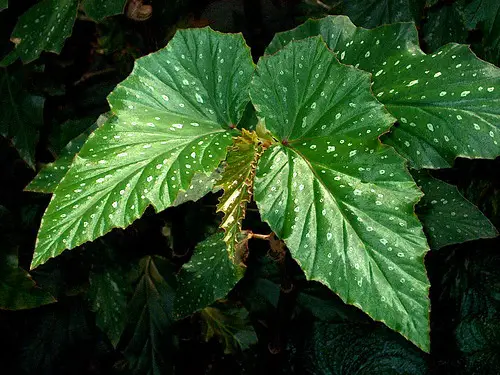The Angel Wing Begonia, named for its distinctive wing-shaped leaves, is a favored houseplant that enchants gardeners with its lush foliage and stunning flowers. These leaves often have attractive silver specks and can display a variety of colors and patterns. The plant’s flowers, which bloom in clusters, can be red, pink, orange, or white.
A member of the Begoniaceae family, Angel Wing Begonia is a hybrid begonia that can be traced back to South America. Easy to care for and visually appealing, this plant has gained popularity among both beginner gardeners and seasoned horticulturists. Its captivating appearance and relatively simple care requirements make it a welcome addition to any indoor garden or conservatory.
Though primarily an indoor plant, the Angel Wing Begonia can also be grown outdoors in some climates. Whether placed on a windowsill, hanging basket, or garden bed, this begonia provides color and texture to any space.
| Attribute | Details |
|---|---|
| Common Names | Angel Wing Begonia, Begonia coccinea |
| Botanical Name | Begonia x corallina |
| Family | Begoniaceae |
| Plant Type | Perennial |
| Mature Size | 1-4 feet tall |
| Sun Exposure | Bright, indirect light |
| Soil Type | Well-draining, peat-based mix |
| Hardiness Zones | 10-11 (indoors in most zones) |
| Native Area | South America |
Angel Wing Begonia Care
Angel Wing Begonia is generally regarded as an undemanding plant that offers a satisfying growing experience. Its primary requirements are bright but indirect sunlight, a well-draining soil mix, and regular watering. Ensuring these basic needs are met will reward the gardener with continuous growth and blossoming.
Because the leaves are susceptible to sunburn and rot, care must be taken to provide the right amount of light and water. Overexposure to direct sunlight or overwatering can cause significant harm to the plant, detracting from its ornamental appeal.
Light Requirement for Angel Wing Begonia
Angel Wing Begonia flourishes in bright but indirect light. Direct sunlight can scorch the leaves, leading to unattractive blemishes. Placing the plant near a north or east-facing window or providing filtered light through curtains is typically ideal for this begonia.
Soil Requirements for Angel Wing Begonia
A well-draining, peat-based soil mix is preferred for Angel Wing Begonia. Adding perlite or sand to the mix can further improve drainage. The soil should retain some moisture but not become soggy, as this can lead to root rot.
Water Requirements for Angel Wing Begonia
Watering should be consistent but moderate, allowing the soil to dry slightly between watering sessions. Angel Wing Begonia enjoys some humidity, so misting the leaves or placing the plant on a pebble tray with water can enhance its growth.
Temperature and Humidity
Angel Wing Begonia prefers temperatures between 60-75°F (15-24°C) and does not tolerate frost. A humid environment is favorable, though too much moisture can lead to problems such as fungal infections.
Fertilizer
Feeding with a balanced liquid fertilizer during the growing season (spring to early autumn) supports robust growth. Fertilize every two weeks, following the manufacturer’s instructions, and reduce feeding in the winter months.
Pruning Angel Wing Begonia
Regular pruning helps maintain the desired shape and removes dead or diseased parts. Pinching back the tips can encourage bushier growth. It’s best to prune in late winter or early spring before new growth begins.
Propagating Angel Wing Begonia
Angel Wing Begonia can be propagated from stem cuttings. Take a cutting with a node, dip it in rooting hormone if desired, and place it in a soilless medium. Keep it moist and warm until roots develop.
How To Grow Angel Wing Begonia From Seed
Growing Angel Wing Begonia from seed is a more time-consuming process but can be rewarding. Start seeds indoors, sowing them on the surface of a well-draining mix. Keep the medium moist and warm, and expect germination in a few weeks.
Common Pests & Plant Diseases
Spider Mites
Treat with insecticidal soap or neem oil.
Powdery Mildew
Maintain good airflow and avoid excess humidity.
Common Problems With Angel Wing Begonia
Yellowing Leaves
This could be a sign of overwatering or nutrient deficiency. Adjust care as needed.
Leggy Growth
Often caused by insufficient light, moving to a brighter location can solve this issue.
Pro Tips
- Rotate the plant regularly to ensure even growth.
- Avoid watering the leaves directly to prevent mildew and rot.
- Keep the plant away from cold drafts or heating vents.
- Monitor regularly for pests and diseases to catch any issues early.
- Repot every couple of years to refresh the soil and provide room for growth.

